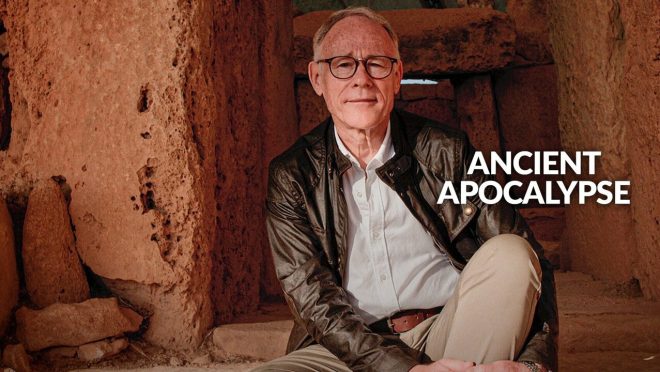Ancient Apocalypse on Netflix: An unconventional look into human civilisation
Ancient Apocalypse on Netflix: An unconventional look into human civilisation

In this expansive era of scientific understanding, there remain many unanswered questions that spark intrigue and forewarn us about the future. “Ancient Apocalypse” is an eight-episode documentary series on Netflix that delves into these unanswered inquiries, exploring why the scientific community staunchly resists new hypotheses that challenge conventional beliefs.
The focal point of this documentary is a single individual, a journalist renowned for his works such as “Fingerprints of the Gods” and “America Before: The Key to Earth’s Lost Civilization.” While one should not judge a book by its cover, the titles alone suggest that the writer has a penchant for exploring unresolved discoveries. The writer in question is Graham Hancock, who not only drives the research behind the series but also serves as its host.
The conventional theory posits that human civilisation emerged around 5,000-6,000 BC, with humans predominantly existing as hunter-gatherers dispersed globally before that time. However, Hancock vehemently criticises this conventional theory as an ideology, urging for deeper exploration. In this series, he embarks on a journey to document various archaeological wonders, presenting substantial evidence of human capabilities that predate the accepted theories.
Each episode features Hancock introducing a megalithic structure from different parts of the world. While detailing the sites, he delves into the surrounding myths, many of which narrate a catastrophic event that obliterated an advanced civilization. Hancock cites similarities in these stories across various cultures, including the story of Noah’s Ark in the Abrahamic Regions. These intriguing connections are backed by the carbon dating of the stones, revealing dates earlier than 6,000 BC, ranging from 11,600 to 12,800 BC, coinciding precisely with the conclusion of the last ice age. Despite acknowledging evidence of a civilisation predating the established timeline, the mainstream remains resistant to Hancock’s proposals.
Hancock highlights the precise cosmological alignments of these structures, exemplified by the stone blocks in Gobekli Tepe, Turkey, and the Pyramids in Mexico. He argues that it is implausible for hunter-gatherers to abruptly unite and construct these massive structures that rival even the most intricate Egyptian mythology. Hancock suspects the existence of advanced civilisations before the last ice age, suggesting a catastrophic event that led to their demise.
Collaborating with Randall Carlson, an architect who proposed the Younger Dryas impact hypothesis in 2007, Hancock presents evidence of a comet impact around 12,800 BC, contributing to the end of the ice age. Hancock postulates that this impact serves as the basis for the global flood myths found in diverse cultures, bolstering his findings of a human civilization predating the ice age.
Despite the compelling nature of Hancock’s hypotheses, concrete evidence remains elusive. The archaeological community largely shows disinterest, even barring Hancock from accessing a site in North America during Episode 6. Hancock also sheds light on the issues he faced with Wikipedia, highlighting the reluctance of the archaeological community to venture beyond their established orthodoxies, which they profit from through university tenure and publications.
Hancock gained initial recognition following his appearance on the widely acclaimed Joe Rogan Experience in 2017. During the podcast, Michael Shermer, director of The Skeptics Society, and founding publisher of Skeptic magazine, challenged Hancock’s theory, raising pertinent questions such as, “If this civilization existed, where are their trash heaps? Where are their homes? Where are their stone tools or metal tools? Where is the writing?”
The theories presented in the series have faced criticism from archaeologists and other professionals for lacking substantive support, presenting easily refutable claims, and for accusing “mainstream archaeology” of conspiring against Hancock’s ideas without valid evidence. Archaeologists have connected Hancock’s statements to 19th-century “racist” and “white supremacist” perspectives, which they find offensive to the ancestors of indigenous peoples. Notably, a Maltese archaeologist featured in an episode claimed her interview had been manipulated. Initially labelled as a documentary, the series was later reclassified as science fiction by the Society for American Archaeology (SAA) due to its perceived intention to disparage archaeologists and the field of archaeology itself.
“Ancient Apocalypse” has undoubtedly emerged as one of Netflix’s most controversial offerings. Yet, the question arises: why was the series produced in the first place? Some speculate that the involvement of Hancock’s son, Sean Hancock, as the senior manager of Unscripted Originals at Netflix, could be a significant factor.
Despite the controversies, “Ancient Apocalypse” remains an engaging watch, well worth the time. The series boasts stunning cinematography, capturing diverse locations worldwide. The animated segments effectively illustrate myths from different corners of the globe, while the host himself, Hancock, commands attention and prompts viewers to ponder the implications throughout the series. Regardless of which side one aligns with, it is undeniable that Hancock’s theory, supported by carbon dating, strongly indicates that human civilisation indeed predates 6,000 BC. For enthusiasts of history, human evolution, and uncovering truth, this is a must-watch.
The writer Nazmul Haque is an Edge Associate of TBS Graduates from National Institute of Textile Engineering and Research (NITER). You can contact him at [email protected]


